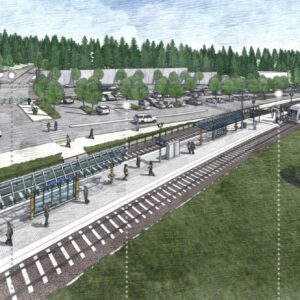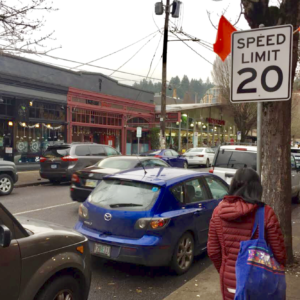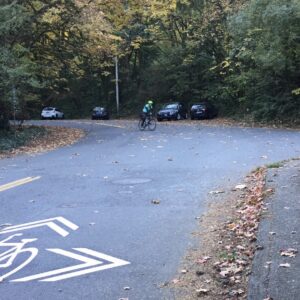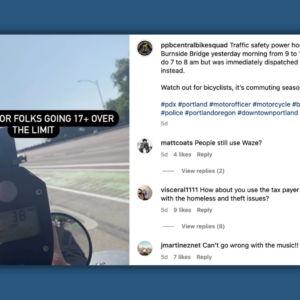
(Photo: Ryan Fedie)
According to Bloomberg CityLab, Europe is slowing down. Paris already has speed limits of 30 km/h (18 mph) over 60% of the city, and is considering generalizing that limit to the entire city. Spain recently followed suit and reduced the speed limit on all two-lane urban roads to 18 mph, and went down to 12 mph, “on streets which lack a clear delineation between roadway and sidewalk,” which are common in the medieval core of some cities.
Here in Portland, our city has a “20 is Plenty” speed reduction program which covers 70% of our streets. As Scott Kocher wrote for BikePortland last winter, “That’s impressive. However, PBOT has not rolled out 20 mph as directed by the ordinance on collector streets in residence districts in most of the city. If you live on or use one of these streets, you’re not getting the level of safety and comfort you’re entitled to.”
In other words, we have room to improve. Especially in southwest Portland.
Advertisement

(Source: PBOT speed limits map)
Southwest Portland has plenty of roads without a “clear delineation” between bicycle riders, walkers, and drivers — and many of them are collector streets currently posted at 25 mph (like SW Vista in the photo above). One of them, SW Capitol Highway, has recently been in the news because it is slated to receive a full suite of active transportation improvements — curb-protected bike lanes, six foot sidewalks — for a $26 million price tag, after a 30-year gestation period and over a length of just one mile.
At that pace and price, it is hard to imagine constructing a safe bike network in the southwest within the lifetime of someone who’s already middle-aged. In the meantime, the city could improve safety outcomes by following through on its “20 is Plenty” program and lower the speed on all collector streets in residential districts.
This is particularly important for SW Portland because it’s not laid out with a tidy grid. Often there are no alternate routes, especially if you are trying to go some length north or south, in which case your choices are limited to either SW Terwilliger Blvd or SW Montgomery Dr.—>Dosch Rd.—>30th Ave.—>Capitol Hwy.

And yet PBOT is making progress. Take the SW Montgomery to Capitol Hwy project (which will break ground next year). SW Montgomery to Talbot recently got sharrows. Improvements at the Vista and Patton crossings are scheduled for this spring.
If we could slow cars down to 20 mph on SW Dosch Rd, we’d have the start — a backbone at least — of a safer bike network.
— Lisa Caballero, lisacaballero853@gmail.com
— Get our headlines delivered to your inbox.
— Support this independent community media outlet with a one-time contribution or monthly subscription.






Thanks for reading.
BikePortland has served this community with independent community journalism since 2005. We rely on subscriptions from readers like you to survive. Your financial support is vital in keeping this valuable resource alive and well.
Please subscribe today to strengthen and expand our work.
Speed at impact is directly related to crash severity outcome, and speed is associated with crash frequency, but lowering speed limits has only been shown to reduce 85th percentile speeds by about 3 mph for each 5 mph posted change (85th percentiles are often higher than posted).
The same topography that limits a grid system of streets on the west side means the through streets that do exist are often called upon to do most everything, including emergency access. Dosch is a District Collector north of Vermont, the same designation as Multnomah or Capitol Highway, or NE 33rd north of I-84. It is also a Major Emergency Response Route. Such roads are not just for neighborhood traffic, but for traffic across the multiple neighborhoods all around the road.
Contrary to Mr. Kocher’s assertion, enabling posting below 25 mph is not directing such posting. What might be of greater benefit is the ability to post local streets to 15 mph, but state law is very specific about the conditions needed to do so.
A modification to current road standards that requires paved shoulders as a minimum could provide significant benefit to all road users particularly on roads like Dosch. Fire-friendly traffic calming could reduce speeding on many of our busier streets, but is not currently allowed on streets classified higher than Neighborhood Collector (one below District) and Portland Fire and Rescue has veto authority for Major ER routes.
The problem is not as simple as new speed limit signs.
Most of the USA, including East Portland, has a lot of the same issues as SW, but often not the topography. One possible solution I saw in Tuscaloosa Alabama was to allow parking on one side of the street, then the other, every alternating block, to create a chicane that slows traffic by using parked cars (please note the pavement markings):
https://www.google.com/maps/@33.2087174,-87.5591527,3a,75y,270h,90t/data=!3m6!1e1!3m4!1skotNNPxjjH7hrJXavM3dzw!2e0!7i16384!8i8192
Dosch is a two lane un-curbed rural road with ditches on either side for most of its length.
Thanks for those insights paikiala! I especially like your idea about paved road shoulders as a minimum. Even a few feet can make a big difference. And I hear you about the complexities of speed and making safer streets. However I know one thing that’s proven to never work – staying silent about the issue. We’ll keep making noise (and listening to experts like yourself) until something sticks.
But aren’t they NOT allowed to pave the shoulders until stormwater facilities are built? We in SW hear this argument all the time: nothing can be built unless there are accompanying stormwater facilities, which increases the cost of every project by 10X. But of course that rule didn’t apply when the streets were initially built and paved. It’s so frustrating.
Rules change over time. ‘storm water facilities’ can take many forms and does not require underground pipes.
@paikiala — Do the rules permit remediation in a location different than the project site? i.e. can we get “credit” for reducing runoff in an area near the project, or does it need to be specifically at the project site?
Adding Stormwater facilities to roadway expansion projects does not increase the project costs by 10x. And, they (City) are required by local and state rules to treat Stormwater from new impervious area (pavement and concrete). Southwest was developed before modern development guidelines and, in many cases, prior to City annexation. We have been dealt a difficult hand that requires costly solutions to retrofit multi-modal transport options.
Thank you for your comment, paikiala. I agree with your observation that “the same topography that limits a grid system . . . means that the through streets that do exist are often called upon to do most everything.”
That’s the rub, how to fairly allocate between the various needs. As Mingus Mapps said in his recent BikePortland interview, “balancing the needs of bikes and cars is a fundamentally difficult problem.”
I’m not a lawyer, I’ve read the city ordinance, it’s only two pages long and written in plain English. It states:
According to the ODOT TransGIS, Dosch is classified as an “Urban Collector” by the Federal Functional Class – Non-State. It’s not an arterial, and I don’t see the category “District Collector.”
I am always open to learning more, and maybe the ordinance has been modified and I missed it, but I don’t see anything that indicates that Scott Kocher’s analysis is incorrect.
The ordinance also finds that “the 2035 Comprehensive Plan prioritizes walking above all other travel modes when making transportation decisions.”
As I’ve mentioned in another discussion, PBOT will not pave shoulders due to runoff rules – you hit 500 sq ft and you need to swale or pipe it, and they disbar most swales due to soil conditions/landslide risk. So sure, small bits here and there, but no large stretches. Aside from possibly a few SWIM or Safe Routes to Schools, SW isn’t getting any hard-surface improvements… cars will be speeding by people separated from them by a mere stripe of paint. So much for Vision Zero!
Yep – you nailed it, CCT! No new pavement can be added in SW w/o stormwater facilities. It’s why one mile of SW Capitol Hwy improvements will cost in the neighborhood of $30M and took 30 years to happen.
@paikiala let’s connect offline and see if we can learn where we disagree.
I truly don’t see how Portland’s ordinance can possibly be read as merely “enabling posting below 25 mph.” The ordinance (PDF download) is here:
https://efiles.portlandoregon.gov/Record/11631411/File/Document
Using legally defined terms, it directs PBOT to post speed limits at 5 mph slower than the statutory speed on non-arterial streets in residence districts:
“a. Consistent with newly amended ORS 810.180, the City of Portland establishes
by ordinance a designated speed that is five miles per hour lower than statutory speed on non-arterial streets under the jurisdiction of the City of Portland in a residence district.
“b. The Bureau of Transportation shall update speed limit signage consistent with ORS 810.180 to inform people driving of the new speed limit.”
Any variance would require an act of City Council.
Similarly, state-wide speed-setting laws dictate what the speed shall be based on street classification and land use. It would be simiarly imprecise to say that those laws “enable” ODOT or transporation agencies in counties or other cities to do as they wish. Variance from those statutory speeds requires an order of the Speed Zone Review Panel. (There are many such orders, many of which are decades old, and many of which set speeds higher than statutory, including in Portland, particularly on arterials.)
Understanding safe speeds as being mandatory is important for transportation agencies, just as it is for drivers. Going the speed limit is a duty drivers undertake when they sign their driver’s license, not a suggestion to be disregarded if you can get away with, say, going 10 over. Likewise, agencies are responsible for posting speed limits as directed by law, and engineering their streets so that people don’t routinely exceed the posted speed.*
Speed limits are one of the few legal lines in the sand that define how much pollution, noise and danger communities must endure. If people don’t understand speed limits as endowing rights upon residents and other roadway users, we’ll continue to see more crashes, more deaths, more fast traffic on our streets, and rich people buying their way into the increasingly small pockets of the city (or suburbs) where calm and safety can be found.
*This 2016 opinion, Turturro v. City of New York, from the highest court in New York is worth checking out:
https://scholar.google.com/scholar_case?case=6707891871932019513
It affirms that transportation agencies don’t just have a duty to post speeds as specified by law (a no-brainer), but affirmatively to “conduct a traffic calming study … [and] implement traffic calming measures” where there is reason to believe there is dangerous speeding. This was the Court’s conclusion:
“We therefore conclude that the specific acts or omissions that plaintiffs claim caused the injury arose from the City’s failure to keep Gerritsen Avenue in a reasonably safe condition. Specifically, the City failed to conduct an adequate study of whether to implement roadway design changes that would have controlled speeding. As such, the City was acting in a proprietary capacity. Plaintiffs had no obligation to prove special duty, and the City cannot rely on the governmental function immunity defense.”
Unfortunately, there are actually no 20 mph streets in Portland.
Well, sure, there are lots of new 20 mph speed signs, but there’s little if any evidence that motorists have slowed down. Especially with the pandemic, there is virtually no enforcement of any traffic laws in Portland.
More and more often, I’m seeing motorists in my neighborhood rolling through stop signs at 10 mph and driving at 30 mph.
Try driving at 20 mph and see how long it takes before there’s another motorist on your bumper.
When I’m driving the speed limit and someone tailgates me, I may actually slow down because I want them to have more reaction time in case I need to stop abruptly.
slow speed divers stop paying attention. there have been many tests proving this. slwo roads are more dangerous, people start looking at phones, playing with radio, grabbing things under seats
Do slwo speed divers attempt to comment while driving?
I’ve found if I speed up my typing my typos decrease, because I have to concentrate more.
Wut?
So. You are saying… faster is… more safe. I’m all for it (not) if the test documentation agrees. Can you point me to that?
I actually remember a famous race car driver (Al Unser? Mario Andretti?) making that same argument several decades ago about freeway speeds. I’m not kidding, I really do remember it. I recall him saying make it a minimum 80 or90 mph and it will become much safer because people will have to pay attention when they drive.
Just to be clear, the reason I remembered it all these years was that it struck me as so incredibly stupid.
All you have to do to see this is true is watch people go by on a 20 mph street. Count the number of distracted drivers on their phones. We have to consider unintended consequences when we make policy. Add to this the loss of life by people spending more time in their car, and it is not clear 20 mph saves any lives. The statistics for Portland have gotten worse since these were instituted, IIRC.
Sorry, AJ, but this argument is BS. People are on their phones at ALL speeds in ALL conditions. I see it ALL the time.
Prove the stats have gotten worse. Give us a link.
Example of tests?
Rear-end horror crashes due to texting are rare and, anecdotally, the ones I’ve seen tend to be on highway straightaways (e.g. texting teen driver killed person biking on US 30 in Columbia County a few years ago). Hard to text and steer. Maybe this (and relatively few intersections compared to the urban grid) is why there have been zero (?) crashes killing people on bikes in the west hills in recent years (knock on wood) despite a lot of riding there. PSU is supposedly compiling speed and crash data before and after the 20 MPH signs. (Update anyone?). I becha crashes didn’t go up. Maybe the best solution is refuge islands, raised crosswalks and intersections, trees in the median, and other calming features that require drivers to look where they are going, make a small meander (or risk scratching their paint or denting a rim) and keep speed in check at least every 260’. Those features become pretty doable on 20 mph streets, now that we have that.
Prove it. Provide a study citation. Drivers do all the same things at high speed and that is much more dangerous. Your believe is not fact.
Sharrows are not “progress”. Multiple studies show that Sharrows do not help, but if anything seem make things worse. The meaning is subjective and open to a wide variety of interpretations by the driver. They showed many drivers interpret the signs as indicating that bikes need to get out of the way.
“Bicycles may use Full lane” signs are more clear and at least one study of the behavior data is very encouraging. Yet PBOT keeps installing Sharrows and then its referred to as “progress”. Its not.
See…
Effects of “Bicycles May Use Full Lane” Signs on
Bicyclist and Motorist Behavior along Multi-Lane Facilities.
Portland doesn’t use sharrows on multi-lane facilities, but on relatively low-traffic streets with one lane in each direction (with the exception of the St. John’s bridge)
The bridge is ODOT.
Council Crest’s popular defacto recreation multi-modal Fairmont/Talbot loop is the worst 25 mph street in SW. Only time before a walker, jogger, or cyclist gets hit by OHSU short-cut commuters. Traffic calming please. Diverters would be best for portions? How about: Talbot three-way intersection to the Greenway underpass? Marquam Hill Rd.to McDonnell Terrace? Himes to Chesapeak?.
Yes to traffic calming, but I don’t think diverters are the right approach here. When I ride Fairmount I’m constantly having to veer around people (groups of walkers, people who inexplicably let their dogs walk down the middle of the road, giving people extra space during Covid, etc.). I think diverters would make this dangerous. I would very much love to see speed cameras around Fairmount and on Gibbs/Marquam. People definitely slow down for the ones on BHH.
In SW I’m beginning to think that sidewalks are covered in Covid because I almost never see people using the sidewalks. They are walking in the bike and traffic lane. The top picture is the perfect example. There is a sidewalk on the other side but the kids are walking in the bike lane which forces me to ride in the car traffic lane. A few weeks ago on Fairmount there were literally 3 people walking abreast on Fairmount on a blind corner. Where am I suppose to go as a cyclist? Into the opposing lane?
You are not going to get Covid passing someone on the sidewalk. You are only within 6 feet for a couple of seconds and there is great ventilation. It is just not that busy in SW. It is safe to walk on the sidewalk!
Jon, I’m so glad someone commented about the photo. My reaction was different from yours, but maybe thats because I’m the mother of a son. I had a fit for their safety–two young children walking an arm’s length away from speeding cars.
But there is a little more to the photo than that, and if you know the area it nicely illustrates many SW problems. The children have just come down that staircase, which was probably built for access to the old trolley line. The reason the kids take that shortcut is because they would otherwise have to walk a long ways uphill to Carter Ln in order to safely cross Vista.
Let’s say they are going to Zupan’s to buy candy. They’d have to walk a ways uphill, cross Vista, walk back down hill, and then recross Vista at Park or Burnside to reach the store. I’m not saying it’s legal, or a good idea, but I understand why they do it. It’s a typical SW connectivity problem.
I’d add that you can’t safely cross AT the stairs because it’s a blind corner and people are coming fast down Vista. I used to run there all the time, and I’d cross TO the stairs, because I could see further up Vista, but never FROM the stairs. And even that would have been dicy if I hadn’t been running across.
One more thing about the sidewalk on the other side of the street. The railing always freaked me out. It’s designed with sharp steel daggers pointing upwards every several inches for hundreds of feet. One trip while you’re walking or running could blind you. I’m probably more sensitive about it due to being clumsy, and also having known someone who was blinded by a sharp wooden post on the back of a chair. The points are totally pointless–I mean totally needless and dangerous, and prevent use of the railing as a handrail for people that need it, say when you’re walking downhill in icy weather.
https://www.google.com/maps/@45.5177841,-122.6968253,3a,79.1y,85.69h,86.23t/data=!3m6!1e1!3m4!1smQePFgs9ivjM9HgFbz3ScQ!2e0!7i16384!8i8192
Ha! My child was actually nearly blinded by that fence! Running along in a puffy winter coat, one hand bouncing off each spearpoint like a card in bike spokes. I knew what was coming, and just as I was yelling ‘stop’ their coat stuck on a point, they were pivoted in towards the fence, and the spear missed their eye by less than 1/2″. Still has a scar.
I’d argue that this dubious distinction goes to Skyline between Sylvan and Burnside. Someone would have to pay me a lot of money to walk or ride there. The speed limit may be 25 but people regularly do over 40, there’s multiple blind corners, and the traffic can be quite heavy.
But it says something about the sorry state of affairs in the area when we can even have this debate.
Isn’t Skyline 35 mph?
Not that section.
+1 for Skyline north of Sylvan. Yuck. Speed bumps. And climbing bike lane at least.
Without enforcement I don’t think simply lowering the speed limit really helps. I live on a Greenway street. It’s residential and 20 mph. People blast down it at 35 mph on a regular basis. Recently the speed limit was lowered on an arterial near me from 30 to 25 mph. PBOT made a big fancy announcement about it on NextDoor. When I asked if there would be any enforcement with the speed limit change they replied “No”. Drivers routinely go 35-45 mph on this street and there were 2 pedestrian accidents (car versus child walking) at this location.
Portland won’t enforce its laws as it discriminates against the lawbreakers! We should change the motto from the “city that works” to the “city that enables”.
I find Scott’s quote a bit off considering that streets that have higher speeds are probably the same ones that have easier access to public transportation. They also probably have better infrastructure unlike my sidewalk less, 1/2 mile walk to a bus street that has a worthless 20mph sign that was improperly installed at 4am. But, maybe I’m wrong, but I doubt it. And yes, he’s “entitled” for his most likely over privileged comment.
Doug I’m not sure the context of my quote came thru: PBOT posted 20 MPH signs on collectors in NW but not elsewhere. Why does NW get them but not East Portland? If you believe lower speed limits are a “good” and everyone city-wide has the same entitlement (which they do—the ordinance does not leave out any part of the city), why the higher speeds (and more crashes and deaths) out east? One reason I wrote the piece was to make that point. If that sounds entitled or lacking awareness of privilege I apologize (and I may need you to help me understand).
A couple other thoughts FWIW: Your 4am 20 MPH sign is possibly not worthless. Have you tried… an email to safe[at]portlandoregon.gov or other advocacy to ask for calming on your street, or for whatever it is your street needs? You might not get 7-figure sidewalks but if it is calming, now measured speeds above 20 (not 25) factor into whether calming is needed. And, some designs that are good for walking or biking become possible when the design speed is slower (tighter curves and turns, shorter tapers on refuge islands, maybe closer spacing for speed bumps, more willingness for engineers to allow, say, street trees in a median or other narrowing features). The City has been looking into some other options to make slower streets with no sidewalks better for peds, such as defining walking space on one side or both, keeping speeds down and narrowing the space at the center where drivers have to make room for each other. If your street is in a residence district in Portland and they stripe 2 fog lines 18 feet apart you now have a “narrow residential roadway” which is thanks to the new ordinance 10 MPH (!) and qualifies for engineering to match. It takes months (or years) and it depends on the street and who at PBOT you get. And it doesn’t always work. But when the City does respond that sort of email to safe@ can be some of the best return on relatively little advocacy effort. Part of the hope long term has been first get lower speed limits then get the engineering tweaks to match. Let’s see if it works.